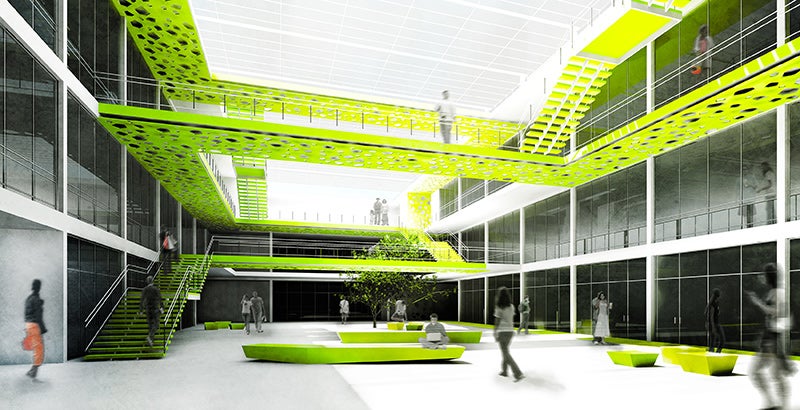Daniel Toole will be paid $4,000 to backpack through Finland, Sweden, and Norway this summer. Baha Sadreddin’s travels through Spain, Germany, the Netherlands, and Denmark this summer will also be covered by a $4,000 check. When they finish their independent three-week trips, they’ll each travel—expenses paid—to New York or San Francisco, where salaried, eight-week fellowships await them (plus a housing subsidy) at a firm specializing in planning, architecture, and landscape architecture.
Toole and Sadreddin graduated from UO four years apart with degrees in architecture and both are now at Harvard’s Graduate School of Design—facts neither knew until a mutual Duck introduced them online. Even more coincidentally, the two men won the only two slots in the prestigious 2014 Hart | Howerton Fellowships.
That Toole, BArch ‘08, and Sadreddin, BArch ‘12, led an Oregon sweep of the fellowships makes the recognition even more exceptional.

Above: The UO Duck Store Courtyard, an academic studio project by Baha Sadreddin. As a social hub for students, the central courtyard unifies circulation throughout the building while providing daylighting and natural ventilation to the spaces around the courtyard. Image courtesy Baha Sadreddin.
“We are really proud that these two top graduates of the architecture department were able to win these wonderful placements,” says Nancy Yen-wen Cheng, associate professor in the UO Department of Architecture. “Baha was a standout from when he entered the first-year program. Dan was a student leader and went on to be active in the Seattle area, working with at least one other UO grad to create a stimulating lecture series on digital craft. I didn't realize that he was also at Harvard, but I am not surprised to hear that. I am happy that our students are empowered to make great opportunities for themselves.”
The fellowships provide two select students a defined summer internship program combined with three weeks of self-directed travel. The fellowships are open to undergraduate and graduate students in architecture, planning, and landscape architecture during the summer before their final year of school.
“Our ability to help students with employment, travel, and financial assistance underscores a continuing commitment to educational opportunity that we share with our staff, clients, and the wider professional community,” the firm’s website states in describing the annual award.
Toole began the Master of Architecture, Urban Design (MAUD) program at the Harvard Graduate School of Design (GSD) last fall. After completing his BArch at UO, he had relocated to Seattle and worked for Perkins + Will for five years before being accepted into the (GSD). Toole won the 5th Annual Cavin Family Traveling Fellowship award in 2011 and is author of Tight Urbanism, which documents alleyways of cities from San Francisco to Tokyo. This fall, he will begin yet another fellowship, a DAAD (German for “German Academic Exchange Service”) from the German government and European Union to research craft culture in building in Berlin. The GSD granted him a leave from his two-year master’s program to spend the year in Berlin.
“I planned to focus my first year [at Harvard] on urbanism and return to my architectural interests in the second year, so now I will go study the role of craft in the building culture of Germany in a place where urban design has played a critical role through a tumultous past,” he says. “I chose to do a MAUD versus a strictly architectural degree to learn about other disciplines, and get a better understanding of the city, and it has totally transformed the way I think and I am very happy about this.“
Sadreddin is enrolled in the post-professional Master in Design Studies in Energy and Environments program at Harvard. “At the GSD, I have had the opportunity to shape my own curriculum focusing on climate-responsive performance-based design,” he says. Also not a stranger to awards, he was on a team that recently won first place in a net-zero building competition organized by the Northeast Sustainable Energy Association. Other honors include six scholarships and/or leadership awards while attending UO. At Harvard, he has been recognized as a Sustainable Community Leader.
Sadreddin also works as a research assistant at the GSD. He interned at Gensler prior to beginning his studies at the GSD. Prior to the GSD, he held internship and research positions at Gensler, CH2M Hill, PiVOT Architecture and University of Oregon’s High Performance Environments Lab.
Through the Hart | Howerton fellowship, Sadreddin will be “studying a series of European eco-districts, performance-based developments, and climate-responsive buildings where components of different scales harmoniously function together to optimize energy flows within the larger system while minimizing the aggregate ecological footprint,” he says. “The aim of the research will be to better understand the thermodynamic implications of transitioning from one scale of design into another while maintaining optimum energy flows, daylighting, and air movement.”
Toole will work in Hart | Howerton’s San Francisco office, while Sadreddin will work in the firm’s New York office. Hart | Howerton is a team of strategists, planners, architects, landscape architects, and designers with offices also in London.

Above: Portland Cultural Forest, Baha Sadreddin’s undergraduate thesis project. The dynamic building skin adapts to changing weather conditions to optimize for daylighting, airflow, and solar gains minimizing the building’s aggregate electric lighting, cooling, and heating loads. Image courtesy Baha Sadreddin.

Above: The Whittier Sustainable Food Center, a design by Daniel Toole while at UO, sought to achieve a porous, dense, vertical form of biologically responsive architecture. Image courtesy Daniel Toole.

Above: Masterplan by Daniel Toole for South Bronx / East Harlem, placing urban amenities on top of a levee system that contains and protects key infrastructural lines including freight, commuter rail, and highways. Image courtesy Daniel Toole.
